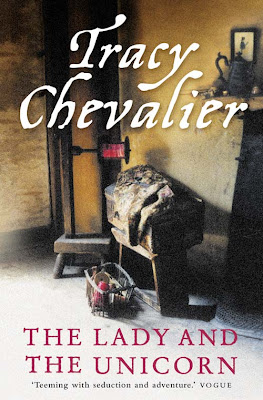There came a moment in my research this week when I realised I was writing about the first tapestry both designed and woven entirely by women at Dovecot. This tapestry was Untitled (1967) designed by Elizabeth Blackadder and woven by Maureen Hodge. It is in the collection of the Scottish National Gallery of Modern Art. Gender does not form a large part of my thesis, but it is an unavoidable topic. It made me think about where tapestry sits in the arguments surrounding women and textiles.
| Maureen Hodge weaving BP Tapestry in 1966. |
Maureen was the first female tapestry weaver employed by Dovecot. She was recruited in 1964, immediately after completing the tapestry course at Edinburgh College of Art. She remained until 1973, when she was appointed head of the college's tapestry department. In 1950 Ronald Cruickshank, Head Weaver told the News Chronicle (9 February 1950) newspaper that he did not employ women as they would leave when they married and presumably he thought the years of apprenticeship would be wasted. This attitude did not change until the 1960s, with the emergence of female graduates from the tapestry course at Edinburgh College of Art.
Tapestry’s domination by men is at odds with the
feminization of textiles, as expressed by feminist art historians such as Rozsika
Parker. Embroidery is one particular example of a medium still dominated by women in
the 1960s. Throughout the decade Embroidery
magazine referred to the ‘embroideress’ or the ‘needlewoman’ instead of the
gender neutral ‘embroiderer’. The editors of the magazine and almost all of its writers were women during the
decade.
 |
| William Morris Company Merton Abbey Tapestry Workshop |
In part, tapestry’s reputation as men’s work comes from its association with
manufacture and factories. In the twenty-first century the western world views
tapestry as a luxury, handmade artifact, but illustrations of earlier tapestry
studios exhibit a less idealist view. The photograph of Morris’ Merton Abbey
workshop
shows a small, cramped studio designed to fit in as many looms and weavers as
possible without losing natural light. In 1950, Dovecot was still considered to
be a factory, as evidenced by correspondence regarding an inspection of the
premises in that year.
Any employee under the age of eighteen needed a certificate from a local doctor
to prove their fitness for work.
However, the domination of tapestry by men can be traced back to pre-industrial Europe and into the Middle Ages. The Tapestry-Maker's Guild stipulated that only women could weave. One of the plot strands of Tracy Chevalier's novel The Lady and the Unicorn concerns the rules that stop weaver Georges de la Chapelle's wife, Christine, from helping him weave the tapestries. Despite this, women could be involved in the preparation of tapestries. In Chevalier's book, Georges and Christine's daughter spends every evening sewing together the slits left between the warps in the tapestry. The involvement of needlewomen is evidenced in Medieval sources. In her publication The Troyes Memoire: The Making of a Medieval Tapestry Tina Kane discusses the account books of the Church of Sainte-Madeleine, also in Troyes. The account books include itemised payment to individuals involved in the commissioning of a series of tapestries for the Church - it is not known whether they were ever woven. These individuals include Poinsete, a seamstress, and her assistant. Poinsete was responsible for preparing full scale cloths for the cartoons to be painted on, and linings for the tapestry. (Kane's book is fascinating, both for her academic insight into her sources and for the translation of the Troyes Memoire itself)
This blog post really just scratches the surface of the matter of women and tapestry. The limits of my research mean I have not had time to spend on it - if you have any comments or further thoughts I would love to hear them!


Visited an exhibition about DOVECOT in Edinburgh last summer, fascinating!
ReplyDelete